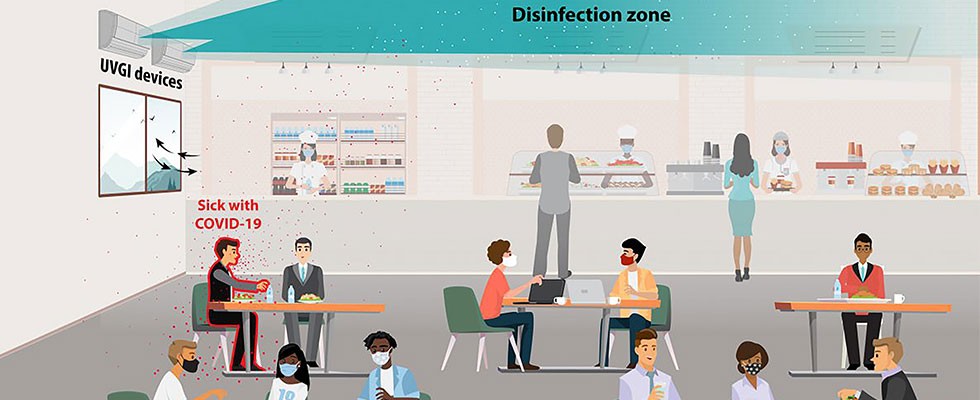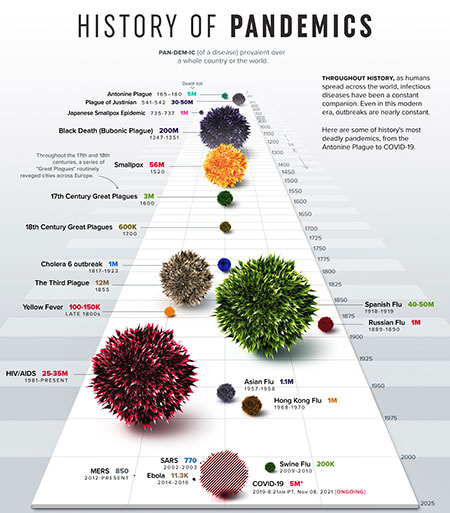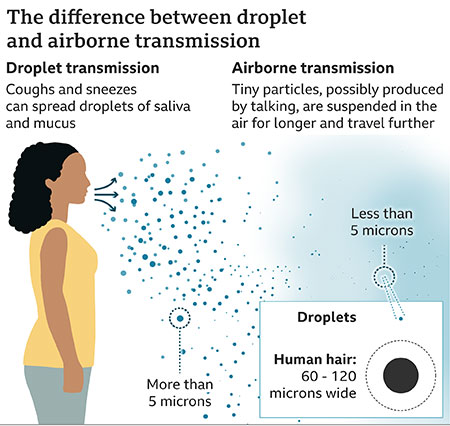
During the COVID-19 pandemic, many people have become more aware of the air that they breathe and how to best protect themselves from harmful pathogens in the air. This is not the first pandemic; nor will it be the last. The world has had eight pandemics since the year 1900, including the Spanish flu, which killed upwards of 50 million people between 1918 and 1920. Protecting senior citizens, the disabled and health care workers from airborne and other infections must be a multifaceted approach.

How Pathogens Spread
Pathogens—or germs—are anything that produce a disease. This includes viruses, disease-causing bacteria and mold. Pathogens are transmitted in several different ways, including through the air, via direct contact, and from surfaces, skin or inanimate objects or substances that can transmit infectious organisms from one individual to another. There are also zoonotic pathogens, which are spread from animals to human and humans to animals.
Humans express droplets that vary in size according to where they originate within the body. Different sized droplets emanate from the lungs, esophagus, nasal passages or mouth. Some of these droplets are large and drop readily to the surfaces and others become aerosolized and can spread as far as 30 feet. These droplets can carry pathogens that can potentially infect others.
According to the Centers for Disease Control and Prevention, most disease-causing pathogens are spread by airborne transmission. The greater the concentration of people in a room, the increased potential for a higher viral load and the spread of
these pathogens.

3 Widely Employed Strategies for Disinfection
The most common disinfection strategies are implemented on a surface level and/or in the air within a building environment.
Surface-level disinfection usually involves cleaning and sanitizing with chemical sprays. Although these are helpful, they are only one part of the equation. In addition, some chemicals may affect individuals who are susceptible to these cleaning solutions. More importantly, these products disinfect only at the surface level and last for a short period of time; they have no impact on airborne pathogens. If someone with COVID-19, flu, MRSA or whooping cough is in the area, they can transmit those pathogens—sometimes without showing symptoms.
Airborne disinfection strategies have several alternatives that include air purification; increased ventilation; controls for heating, ventilation and air conditioning (HVAC); high-efficiency particulate absorbing (HEPA) filters and upper air germicidal irradiation (UAGI). Let’s look at three options in depth.
1. Air Purification
Bipolar ionization (sometimes called needlepoint bipolar ionization) is a technology that can be used in HVAC systems or portable air cleaners to generate positively and negatively charged ions. These ions attach to pathogens, causing them to fall to surfaces, partially eliminating them from being airborne. However, these pathogens can still be acquired by individuals when they touch affected surfaces. There are also potential side effects such as the production of ozone, which can create negative respiratory issues. In addition, there is not sufficient research to fully understand the interaction of charged ions with chemicals used on the surfaces. It is important when selecting a disinfection strategy from a manufacturer to ask for both independent lab and field studies. The favorable results achieved in the labs may not translate to actual results in a live study in the field.
2. HEPA Filters & UV Lighting for HVAC
HEPA filters remove pathogens from the air, whereas ultraviolet (UV) lighting kills the pathogens. These are complimentary strategies, along with increased ventilation (air exchange) to eliminate any pathogens from the building. It is important to understand that that there are dead zones within certain rooms where there is little to no circulation and increased air flow may be difficult and costly for an extended.
UV has been used in health care settings for over a century and is a well documented and recommended infection control solution.
3. UVGI Solutions
Ultraviolet germicidal irradiation (UVGI) equipment disrupts pathogens’ DNA. UVGI should be disbursed at least eight feet above the floor and air exchange should be allowed for at the same time. A high air exchange rate is similar to introducing clean air into the room. A process called “convection” causes warmer air to naturally rise to the upper portion of the room.
UV-C light is deployed in the upper air of the room to inactivate any pathogens caught in the convection currents. Louvers are used to keep the UV-C rays in the upper portion of the room away from the room occupants. This system allows up to 18 air changes per hour and has an efficacy rate of 99.9%.
Note that upper-air UVGI solutions can help reduce both the airborne pathogen load and, in combination with normal surface cleaning procedures, helps further reduce the surface pathogens.
